

The Mythical Power Of Plants Do You Know ? Date Palm Culture exists in the UAE since several thousand years ago as apart of the Gulf ecosystem, from which date palm was propagated around the world.
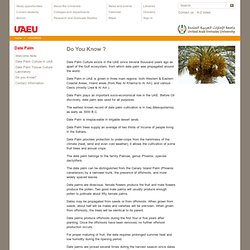
Date Palm in UAE is grown in three main regions: both Western & Eastern Coastal Areas, Inland areas (from Ras Al Khaima to Al Ain); and various Oasis (mostly Liwa & Al Ain ). Date Palm plays an important socio-economical role in the UAE. Cultivar. Osteospermum 'Pink Whirls' A cultivar selected for its intriguing and colourful flowers The International Union for the Protection of New Varieties of Plants (UPOV – French: Union internationale pour la protection des obtentions végétales) offers legal protection of plant cultivars to people or organisations who introduce new cultivars to commerce.
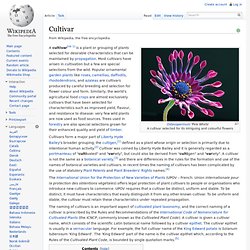
UPOV requires that a cultivar be distinct, uniform and stable. To be distinct, it must have characteristics that easily distinguish it from any other known cultivar. To be uniform and stable, the cultivar must retain these characteristics under repeated propagation. My Cology. New Organica. FlowerChecker, plant identify. Virginia Tech Tree Identification brings the award winning Virginia Tech digital dendrology material to your Android smart phone.
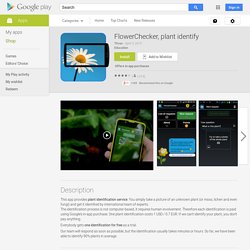
It contains fact sheets for 969 woody plants from all over North America with an in depth description, range map and thousands of color images of leaves, flowers, fruit, twigs, bark and form. Users can narrow the species list for any location in North America using the phone's GPS, network signal or any entered address or zip code. Basically the application can become “Woody Plants of Where You Are Standing”. For example, it can become the “Woody Plants of Southwestern Oregon” , the “Woody Plants of Central Park” or the or “The Woody Plants of 37.108 lat., -80.452 long., elevation 2118”. Users can further narrow the species list by answering a series of very simple tree attribute questions such as where the plant is growing, leaf shape, leaf arrangement, flower color or fruit type.
Text and photography by John R. Bacopa Monnieri - Brahmi Plants For Sale. This herb plant is prized for its medicinal properties.

Used for centuries in traditional Ayurvedic medicine, Brahmi, isused to cure epilepsy and as an anti-aging cure all. It has been proven in contemporary medical studies as an effective treatment for improving memory, anxiety, stomach ailments and as a general tonic to fight stress. It's flavonoid and alkaloid chemical content make it a valuable medicinal herb. Brahmi plants practically grow themselves. Thriving under substandard conditions, the brahmi herb prefers consistently moist to wet soil and can even grow in water gardens.
If you plan to use the Bacopa Monnieri plant medically, be aware that there may be some side effects. The ethnobotany of Christ's Thorn Jujube (Ziziphus spina-christi) in Israel. New Organica. Home - PlantLab. Andean Grains and Legumes. Index|Search|Home Neglected Crops: 1492 from a Different Perspective. 1994.
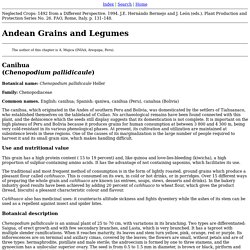
J.E. Hernándo Bermejo and J. León (eds.). Plant Production and Protection Series No. 26. Hortus Malabaricus. In Defense of Seed Libraries — Seed Savers Exchange. Browse. NYIS. Herbs Info - Learn About Herbs, Herbal Remedies and Essential Oils. Medicinal Spices Exhibit - UCLA Biomedical Library: History & Special Collections. Species Information. PLANTS. Trees of India, Types of Trees in India, Tropical Trees of India : Eco India.
Date Palms. Plants. Plant Finder. Argania spinosa information from NPGS. About GRIN - Germplasm Resources Information Network. Phytoremediation. Phytoremediation (from Ancient Greek φυτο (phyto), meaning "plant", and Latin remedium, meaning "restoring balance") describes the treatment of environmental problems (bioremediation) through the use of plants that mitigate the environmental problem without the need to excavate the contaminant material and dispose of it elsewhere.

Phytoremediation consists of mitigating pollutant concentrations in contaminated soils, water, or air, with plants able to contain, degrade, or eliminate metals, pesticides, solvents, explosives, crude oil and its derivatives, and various other contaminants from the media that contain them. Application[edit] Phytoremediation may be applied wherever the soil or static water environment has become polluted or is suffering ongoing chronic pollution. Plant Life. Top 10 Winter Plants" The Japanese maple is a deciduous tree native to Asia.

Some varieties can grow to a height of 25 feet (7.5 meters), with a spread of 15 feet (4.57 meters) in some cases, although most varieties are smaller. They're prized for their fall foliage, which is often red and sometimes golden. There are also a number of dwarf varieties available that are easy to grow and make interesting focal points in the landscape. The overall silhouette of the Japanese maple can vary from vase-shaped to cascading, depending on which type you select, and the leaf shapes are variable too. One thing you can be sure of: The fall display of the Japanese maple will make your garden a standout in the neighborhood.
Top 10 Amazing Plants. After millions of years of evolution and development, an enormous number of different plant variations have been created.
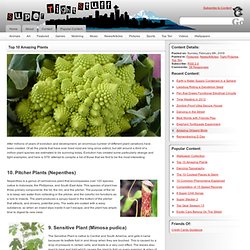
Of all the plants that have ever lived most are long since extinct, but still around a third of a million plant species are estimated to be surviving today. Evolution has created some particularly strange and tight examples, and here is STS’ attempt to compile a list of those that we find to be the most interesting. 10. Le silence des abeilles. Conserving Bees - International Bee Research Association. Conserving our bees by Robert Paxton The title of this article, reflects a growing awareness and interest in the demise of the world's wild bees, and the impact this may have on other wildlife, ecosystems (including agroecosystems) and the world's economy.

The Red Data Book contains a high percentage of the bee species considered to be under threat. Bees. BEES. The Early History of Beekeeping. History of Wild Bees and Beekeeping The beekeeper is the keeper of bee collection of honey and the other products that bees product in the hive like beeswax, pollen, and royal jelly.
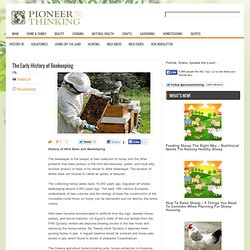
Another product of bees is for resale to other beekeeper. Arabian jasmine. Here is a plant that is grown for one thing really, and that is scent. The leaves are attractive, the flowers are pretty enough, but the fragrance is so intense that it totally eclipses any other traits. This is a Arabian jasmine, or Jasminum sambac, a species of jasmine native to southern Asia and India. It is a rambling evergreen shrub, which will reach 8 to 10 feet in frost-free areas. The pure, snow-white flowers are about an inch across, and are borne in clusters of 3-12. They are powerfully and intensely fragrant.
Money doesn't grow on trees, but there's gold in eucalyptus leaves. Eucalyptus could become a prospector's best friend: a team of researchers say they've proven once and for all that some trees' leaves contain tiny gold particles drawn from deep underground. In a study published in Nature Communications, a group led by Melvyn Lintern of Australia's national science agency CSIRO tested both lab-grown and wild eucalyptus trees for evidence of gold. Microscopic particles have been found before in leaf samples, and researchers have successfully grown plants that absorbed gold through their roots. But the researchers say these studies use gold concentrations higher than anything you'd find in the natural environment, and they rarely focus on the kind of plants that could actually be used to look for gold.
Without evidence to the contrary, it wasn't possible to rule out theories that traces of gold were just deposited along with all the other dust that's swept onto eucalyptus leaves. The team looked for particles of gold growing directly in the leaves. Difference Between Saffron and Turmeric. Saffron vs Turmeric Saffron and Turmeric are two medicinal herbs or spices of varied uses. Turmeric. Turmeric (Curcuma longa) /ˈtɜrmərɪk/ is a rhizomatous herbaceous perennial plant of the ginger family, Zingiberaceae.[2] It is native to tropical Tamilnadu, in southeast India, and needs temperatures between 20 °C and 30 °C (68 °F and 86 °F) and a considerable amount of annual rainfall to thrive.[3] Plants are gathered annually for their rhizomes, and propagated from some of those rhizomes in the following season. Botanical view of Curcuma longa. Turmeric field in an Indian village. India is a significant producer of turmeric[6] which has regional names based on language and country.
As turmeric is a natural botanical product, it is not patentable.[7][8] Saffron. A Tree A Day. The sole extant species in the genus Jubaea, a member of the palm family Arecaceae, is Jubaea chilensis, otherwise known as the Chilean wine palm. It is native to South America and endemic to a small area of central Chile. A Shrub A Day. The oldest spruce in Northern Europe is 532 years old. It looks ordinary but this tree is the oldest of its kind in Northern Europe. Meet The World's Largest Living Organism. When you think of the biggest organisms on Earth, the blue whale probably springs to mind first. Tree Leaf Silhouette - Identify a Tree by Leaf Silhouette. Education. Vital Forest Graphics. Plants Profile for Laurus nobilis (sweet bay) Laurus nobilis : Mobile Results. Hill Country Herbalist: Harvesting Red Clover Blossoms and Making Them Into Tincture. Medicinal Uses of Bee Balm. Growing Echinacea. Using Echinacea. Wildcrafting.net: Foraging Database, Edible & Medicinal Plants.
Traditional Plant Foods Of Canadian Indigenous Peoples, Nutrition, Botany & Uses. 50 Essential Wild Edible, Tea, and Medicinal Plants You Need to Know. Fact Sheets. Guide to Edible Wild Plants in North America. Foraging Guide - Edible Wild Plants of Temperate North America and the UK. Wild Food School - Foraging Data Sheets. Foraging Guidelines. Forestry. Foraging. Seeds, Trees and Bees. Act For Seed. Seeds/Rare plants. Organic Seed Suppliers. Plants. Gardens Delight. Homesteading Garden. ORGANICA. Botany. Biology.